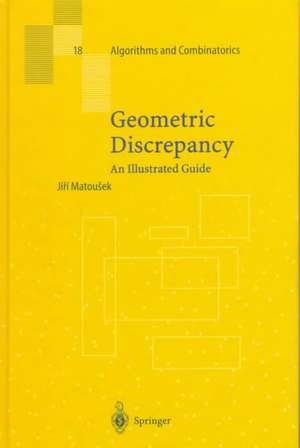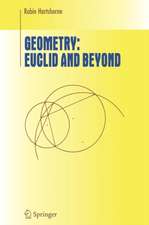Geometric Discrepancy: An Illustrated Guide: Algorithms and Combinatorics, cartea 18
Editat de Jiri Matouseken Limba Engleză Hardback – 19 mai 1999
| Toate formatele și edițiile | Preț | Express |
|---|---|---|
| Paperback (1) | 944.82 lei 6-8 săpt. | |
| Springer Berlin, Heidelberg – 15 dec 2009 | 944.82 lei 6-8 săpt. | |
| Hardback (1) | 950.96 lei 6-8 săpt. | |
| Springer Berlin, Heidelberg – 19 mai 1999 | 950.96 lei 6-8 săpt. |
Din seria Algorithms and Combinatorics
- 18%
 Preț: 1123.67 lei
Preț: 1123.67 lei -
 Preț: 387.38 lei
Preț: 387.38 lei -
 Preț: 391.61 lei
Preț: 391.61 lei - 15%
 Preț: 639.08 lei
Preț: 639.08 lei - 15%
 Preț: 658.22 lei
Preț: 658.22 lei - 18%
 Preț: 965.34 lei
Preț: 965.34 lei - 15%
 Preț: 649.22 lei
Preț: 649.22 lei - 18%
 Preț: 781.00 lei
Preț: 781.00 lei - 18%
 Preț: 953.35 lei
Preț: 953.35 lei - 18%
 Preț: 897.65 lei
Preț: 897.65 lei -
 Preț: 512.18 lei
Preț: 512.18 lei - 15%
 Preț: 638.89 lei
Preț: 638.89 lei - 18%
 Preț: 897.65 lei
Preț: 897.65 lei - 24%
 Preț: 912.87 lei
Preț: 912.87 lei - 18%
 Preț: 979.70 lei
Preț: 979.70 lei - 18%
 Preț: 967.22 lei
Preț: 967.22 lei - 20%
 Preț: 500.19 lei
Preț: 500.19 lei - 15%
 Preț: 593.08 lei
Preț: 593.08 lei -
 Preț: 399.50 lei
Preț: 399.50 lei - 15%
 Preț: 644.18 lei
Preț: 644.18 lei - 18%
 Preț: 972.42 lei
Preț: 972.42 lei -
 Preț: 386.00 lei
Preț: 386.00 lei - 15%
 Preț: 589.14 lei
Preț: 589.14 lei - 15%
 Preț: 642.51 lei
Preț: 642.51 lei - 15%
 Preț: 656.43 lei
Preț: 656.43 lei -
 Preț: 381.43 lei
Preț: 381.43 lei
Preț: 950.96 lei
Preț vechi: 1159.71 lei
-18% Nou
Puncte Express: 1426
Preț estimativ în valută:
181.96€ • 189.98$ • 150.60£
181.96€ • 189.98$ • 150.60£
Carte tipărită la comandă
Livrare economică 04-18 aprilie
Preluare comenzi: 021 569.72.76
Specificații
ISBN-13: 9783540655282
ISBN-10: 354065528X
Pagini: 306
Ilustrații: XI, 289 p.
Dimensiuni: 155 x 235 x 22 mm
Greutate: 0.6 kg
Ediția:1999
Editura: Springer Berlin, Heidelberg
Colecția Springer
Seria Algorithms and Combinatorics
Locul publicării:Berlin, Heidelberg, Germany
ISBN-10: 354065528X
Pagini: 306
Ilustrații: XI, 289 p.
Dimensiuni: 155 x 235 x 22 mm
Greutate: 0.6 kg
Ediția:1999
Editura: Springer Berlin, Heidelberg
Colecția Springer
Seria Algorithms and Combinatorics
Locul publicării:Berlin, Heidelberg, Germany
Public țintă
ResearchCuprins
1. Introduction.- 2. Low-Discrepancy Sets for Axis-Parallel Boxes.- 3. Upper Bounds in the Lebesgue-Measure Setting.- 4. Combinatorial Discrepancy.- 5. VC-Dimension and Discrepancy.- 6. Lower Bounds.- 7. More Lower Bounds and the Fourier Transform.- A. Tables of Selected Discrepancy Bounds.- Hints.
Recenzii
From the reviews:
“The book gives a very useful introduction to geometric discrepancy theory. The style is quite informal and lively which makes the book easily readable.” (Robert F. Tichy, Zentralblatt MATH, Vol. 1197, 2010)
“The book gives a very useful introduction to geometric discrepancy theory. The style is quite informal and lively which makes the book easily readable.” (Robert F. Tichy, Zentralblatt MATH, Vol. 1197, 2010)
Textul de pe ultima copertă
What is the "most uniform" way of distributing n points in the unit square? How big is the "irregularity" necessarily present in any such distribution? Such questions are treated in geometric discrepancy theory. The book is an accessible and lively introduction to this area, with numerous exercises and illustrations. In separate, more specialized parts, it also provides a comprehensive guide to recent research. Including a wide variety of mathematical techniques (from harmonic analysis, combinatorics, algebra etc.) in action on non-trivial examples, the book is suitable for a "special topic" course for early graduates in mathematics and computer science. Besides professional mathematicians, it will be of interest to specialists in fields where a large collection of objects should be "uniformly" represented by a smaller sample (such as high-dimensional numerical integration in computational physics or financial mathematics, efficient divide-and-conquer algorithms in computer science, etc.).
From the reviews: "...The numerous illustrations are well placed and instructive. The clear and elegant exposition conveys a wealth of intuitive insights into the techniques utilized. Each section usually consists of text, historical remarks and references for the specialist, and exercises. Hints are provided for the more difficult exercises, with the exercise-hint format permitting inclusion of more results than otherwise would be possible in a book of this size..."
Allen D. Rogers, Mathematical Reviews Clippings (2001)
From the reviews: "...The numerous illustrations are well placed and instructive. The clear and elegant exposition conveys a wealth of intuitive insights into the techniques utilized. Each section usually consists of text, historical remarks and references for the specialist, and exercises. Hints are provided for the more difficult exercises, with the exercise-hint format permitting inclusion of more results than otherwise would be possible in a book of this size..."
Allen D. Rogers, Mathematical Reviews Clippings (2001)
Caracteristici
Only up-to-date comprehensive guide to the subject Includes supplementary material: sn.pub/extras














